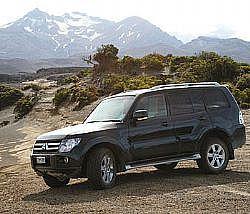It’s no accident the army chooses tough terrain for training its troops, and it’s not often civilians get a chance to encounter these conditions for themselves. However we did just that – in comfort – at the wheel of the latest Mitsubishi Pajeros.
The Waiouru training area is situated off State Highway 1 south of Lake Taupo, mid-way between Taupo and Fielding. It starts level with the road, then climbs up steep slopes towards Mount Ruapehu.
It comprises mainly deep volcanic gravel and sand at its lower levels, bisected by a lazy river, then as you climb higher the tracks become rocky and treacherous, with big holes the 4WD’s wheels drop into, and jagged outcrops waiting to rip the sides out of your vehicle.
It was a good place to test the iconic Pajero, and to see just how much has been changed in what the company describes as its “fourth generation”.
In reality it’s more like a “heavy facelift” than a completely new vehicle, for although the front end has come in for major changes, the back gets fewer, and the whole chassis/platform comes from the outgoing model.
There are a lot of mechanical and technical changes, though, as well as new diesel and petrol engines, while the whole interior comes in for a refit.
The result is a car which looks significantly different, and on the road feels tauter and more robust than its already tough predecessor.
Styling is definitely more European and modern than that of the outgoing model, with fewer swooping curves and a more squared-off appearance, big lights and a very attractive chromed-stripped grille.
Looks great!
Main feature of the rear is that the spare wheel is now set lower on the rear door and centred so it gives better rear vision. All models have roof rails as standard.
Inside there’s a brand-new instrument panel and dashboard with high quality plastics including the latest aluminium look; either fabric or leather is specified, depending on model.
The 2007 range comprises GLS and Exceed specifications for the long wheelbase version while the short wheelbase model has a GLS or sporty VR-X specification, and will only be available by firm order.
“We are keen to test the market with the short wheelbase,” says MMNZ general
manager of sales and marketing Peter Wilkins.
“Consumers don’t have a lot of choice in this part of the serious four-wheel drive segment so we’ve decided to offer the vehicles on a firm order basis to assess interest, until we’re comfortable committing to more significant stock volumes.
“Off-road, Pajero has some of the best ground clearance angles in the segment, it has retained its very successful MATT traction control system which has been bolstered with the addition of hill hold assist, and for serious adventurers we’ve added a rear differential lock.”
This certainly showed during our off-road drive in the vehicles. A couple of times the traction control was called upon to ensure we got through cross-axle situations, and in fact we punched in the rear diff. lock to make it easier over a few of the obstacles.
On tarmac the upgrades to the suspension were apparent, and the Pajero felt much more secure in hard cornering, with body roll in particular much reduced.
Engine options are a 3.2-litre Common Rail intercooled turbo-diesel or a 3.8-litre V6 MIVEC petrol unit.
The Euro 4 diesel delivers 127 kW at 3,800 rpm and 364 Nm at a low 2,000 rpm. A variable-geometry turbo-charger helps produce fuel economy of 10.6 litres/100km, and there’s a diesel particulate filter.
The 3.8-litre V6 MIVEC petrol engine delivers a 23 percent power boost over its predecessor, with maximum output at
184 kW at 6,000 rpm, and torque has risen six percent to 329 Nm at 2,750 rpm. Both engines are coupled with Mitsubishi INVECS II transmissions with sport mode, allowing the option of automatic or manual transmission shifting. All models are rated to tow 3,300 kg braked trailers.
Braking has been significantly improved by adding bigger 333 mm front ventilated four-pot disc brakes to the long wheel base models and 90 mm ventilated discs with two-pot callipers to the short wheelbases.
The long wheelbase Pajero Exceed on 265/60R18 tyres has a stopping distance of 42 metres from 100 km/h.
Safety features
Safety features include dual-stage driver and passenger front and side airbags, while curtain airbags protect occupants in the first and second row seats. There’s also Active Stability Control.
More than 76 percent of the Pajero’s body panels are now galvanised steel as opposed to 46 percent of its predecessors.
There are seven seats in the long wheelbase with five in the short version.
All models feature auto air conditioning, cruise control, power windows, a comprehensive sound system and a multi-mode display with outside temperature and trip computer.
Standard on the Exceed is leather seat trim, available in black or cream colour options, aluminum pedals, a sunroof, manual rear seat air conditioning and a 12-speaker Rockford Fosgate sound system with steering wheel controls.
The third row seat on the long wheelbase folds away to provide a flat luggage area. .:
3.2L Diesel 3.8L Petrol
Short wheelbase GLS $52,990 $49,990
Short wheelbase VR-X $59,990 $56,990
Long wheelbase GLS $66,990 $63,990
Long wheelbase Exceed $76,990 $73,990




